For some good old-fashioned fun, grab your copies of these classic vintage games the whole crowd will love. With ancient games like Mancala (literally!) and mid-20th-century classics like Totopoly, you’ll find a little bit of nostalgia and excitement, along with a wide range of gameplay mechanics, themes, and storylines for a great evening in.
The Appeal of Vintage Board Games
Vintage board games have a unique charm that appeals to people of all ages. They offer a nostalgic trip back in time, allowing players to relive fond memories of their childhood. The tactile experience of holding a physical game board, rolling dice, and moving pieces around the board is unmatched by digital games. Additionally, vintage board games often have a unique aesthetic, with colorful graphics and quirky designs that are hard to find in modern games. Many collectors and enthusiasts also appreciate the historical significance of vintage board games, which can provide a glimpse into the past and showcase how games have evolved over time.
Benefits of Playing Board Games
Playing board games, whether vintage or modern, has numerous benefits for individuals and families. Board games promote social interaction, encouraging players to communicate, negotiate, and work together. They also improve cognitive skills, such as problem-solving, strategy, and critical thinking. Board games can be a great way to relax and reduce stress, providing a healthy distraction from the demands of daily life. Furthermore, playing board games can foster a sense of community and togetherness, creating shared experiences and memories that can last a lifetime.
The Eight Best Vintage Board Games for Nostalgia Night
Mexican Train
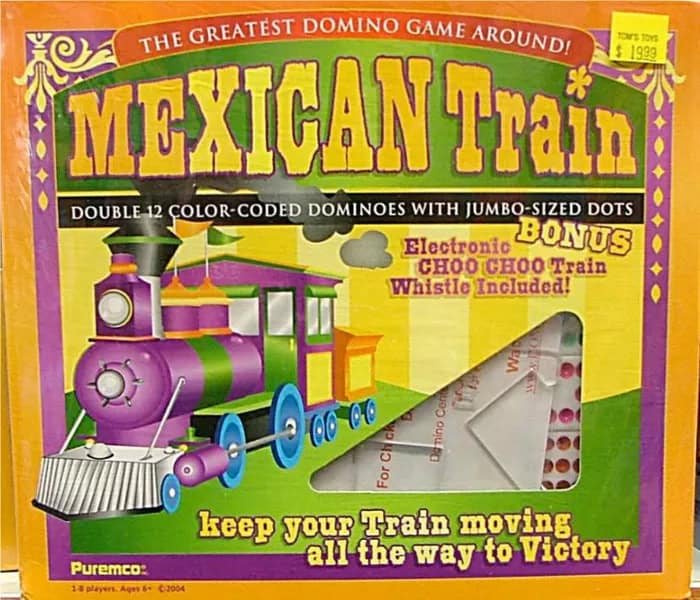
Age: 10+ (Community 6+) Players: 1-8 Time: 20+ minutes
The classic domino game Mexican Train has become an extremely popular game since its initial copyrighted launch into the world in 1994. The game finds its origins in much older domino play, dating back as far as the Song Dynasty of China in the 900s. Of course, the game of Pai Gow, believed to be this game’s origin, has shifted and changed numerous times over the centuries, ultimately resulting in many spin-offs and variations, now culminating in Mexican Train.
The domino game variant is both simple and interactive, meaning that the flexible game which may last anywhere from 20 minutes to several hours, provides loads of gameplay, variability, and replay-ability. Technically, you can play Mexican Train with a standard set of Dominos, but brand versions make the play even easier and more visually stimulating with a train station, specially marked pieces, train whistles, or other fun accessories.
The game is usually played with a double-twelve domino set, involving 91 tiles. Each player’s goal is to get rid of their dominoes first, starting with the highest double tile placed in the middle of the table (the train station). Players then create their line of dominoes (their train) or add to the Mexican train (anyone can add to this) on their turn. If a player cannot lay down a single domino on their turn, they must draw from the domino pile. To speed things up, players may play simultaneously, turning the game into a race to get there first. Once a player runs out of dominoes, the remaining players add up the points of their remaining dominoes. Whoever has the fewest points after all rounds of the game are played is declared the winner.
Mancala
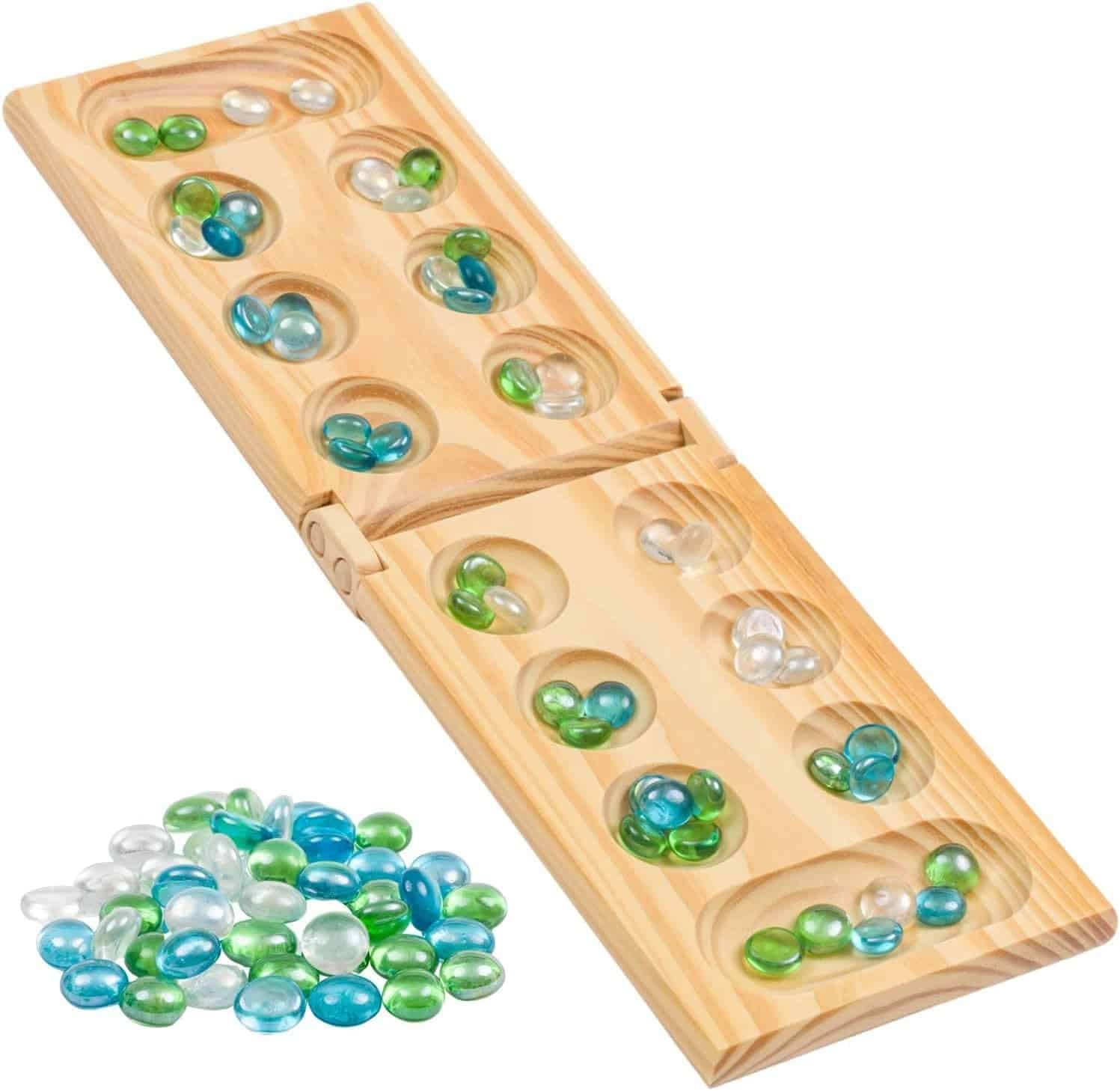
Age: 5+ (Community 6+) Players: 2 Time: 10 minutes
Mancala or Kalah offers 2 players a simple game that requires strategy and critical thinking to engage with the vintage game. You’ll find many versions of this one, as the classic game hasn’t been copyrighted outright. Rather, each version comes from the original game that originated some 3,000 years ago in Africa (or at least that’s the belief). Officially, Mancala accommodates players as young as five, but most folks say six is a better age for play to start.
Gameplay for Mancala is both competitive and collaborative, with times usually running about 10 minutes per game. It’s easy to learn the rules and execute the play, which starts with the board being placed between the participants. Each side of the board has six holes and a larger hole on the ends (known as the mancala or store). Four pieces (marbles, stones, or other counters) are placed in each of the six holes on each side, with the mancalas left empty. One player begins by choosing one of the holes on their side of the board. The player then picks up the stones in that hole, then places one of them into the next hole on the board, rounding the board counterclockwise until no more stones are left in the player’s hand. If you are able to place a stone in your mancala, add that counter and continue placing those remaining in your hand as you move into the opponent’s side of the board. Keep going until the stones are gone, but never place one of the stones in your opponent’s mancala.
Players continue taking turns doing this with two exceptions: an extra play or a capture. If you place the last stone in your hand into your mancala, you get another turn, and so should pick up the counters from another hole on your side and continue playing. On the other hand, if the last counter in hand is placed in an empty hole, you then capture all the stones in the hole opposite the empty one you just placed a counter in, plus you recapture that last counter. All of these counters go straight into your mancala. When a player has no more counters on their side of the board, the game ends. The person with counters remaining on their side of the board captures their own counters and places them in their mancala. Whoever winds up with the most stones wins. It may sound a little complicated, but in actuality, once you start playing, the rules make perfect sense and gameplay is easy.
Parcheesi

Age: 5+ Players: 2-6 Time: 30 minutes
You may not realize it, but the vintage board game Parcheesi originated in India as Pachisi, all the way back in 4 AD. The national game of Bharat (India) has changed over time, of course, but today the challenging game of pawns has become popular around the world with players 5 and up.
In Parcheesi, each player starts out with a set of pawns in their corner of the game board. Players must move their pawns around the board towards the home section, via dice rolls. But watch out for your fellow players – they’ll try to capture your pawns and return them to your corner where their journey must start over again. The winner of this two- to four-player game is the first to get all their pawns home. Some versions of the game can handle up to six players, with an adapted board to resolve the “corner” issue. Additionally, you can find double-sided board versions or the Juegos de la Antiguedad Parchis version which accommodates up to 8 players.
If the rules feel similar to Sorry!, you’re not wrong. The original game of India is the basis for it and the primary difference is the use of cards instead of dice rolls to control player movements.
Masterpiece: A Vintage Game

Age: 10+ (Community 8+) Players: 3-6 Time: 60 minutes
Whether you already know and love the masters like Rembrandt, Renoir, and Van Gogh, or want to sink into the world of Masterpiece artwork, this vintage game is a showstopper with fun bidding and bluffing play. Tension will rise as you aim to claim the true masterworks and spot the forgeries before bidding, convince others they’re just fakes, or otherwise trick your friends into losing out on some of the most incredible artwork in the world.
Your aim in Masterpiece is to take on the persona of eccentric characters in the art world and bid your way into masterpieces through randomized card play. At the onset of the game, cards containing the masterpieces are placed facedown in a stack. Matching-sized cards get mixed into the stack, with each card indicating the value of the artwork or the forgery, ranging from $0 to $1 million. Each player receives a sum of money to start – equal amounts all around – and one painting card. Only the owner of the painting knows its true value. Value and painting cards are clipped together, hidden for only the owner to see. Then paintings are drawn from the stack and another value card is drawn and clipped to this card. Players then roll a die and advance around the board, receive paintings from the stack, sell paintings to the bank for their value or a specified amount, auction off paintings to the highest bidders (game opponents), or auction the top painting in the stack. The gameplay ends when the painting stack is empty. As players go about these tasks, they must bluff their way through forgeries, desire for any given painting, and more to fool fellow players and ultimately power play their way to victory. The person at the end of the game with the most cash in hand wins.
Sherlock Holmes’ Consulting Detective
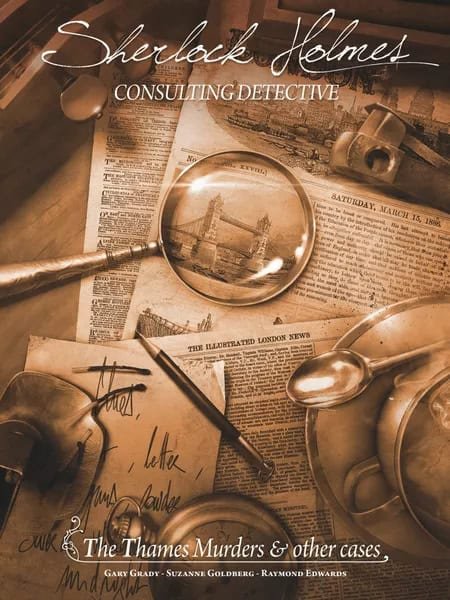
Age: 13+ (Community 14+) Players: 1-8 Time: 60-120 minutes
Sherlock Holmes mysteries are truly classic literature – but those mysteries were translated long ago to the board game world, with the vintage darling Sherlock Holmes’ Consulting Detective game beloved by many throughout the years. The game was first released in 1982, pulling players into the world of Sherlock, Moriarty, and Victorian London for a deductive good time.
Land in Baker Street Sherlock’s home agency and dive into the mystery-solving world of Watson and Holmes in the challenging game. Become Sherlock Holmes himself and interview suspects, follow evidence, and explore 19th Century mansions so you can declare, it’s just “Elementary, my dear Watson!” as you solve the case. Discover the cause of two lions murdered in Hyde Park, reason out who stole the paintings from the National Gallery, find the fiend who murdered Oswald Mason, or clue your way through any of the other cases included in this challenging game. No dice nor luck help you deduce the clues in this non-traditional vintage game. Instead, engage your brain to figure out whodunit in this thoroughly researched Holmesian-Victorian game.
Mystery Mansion
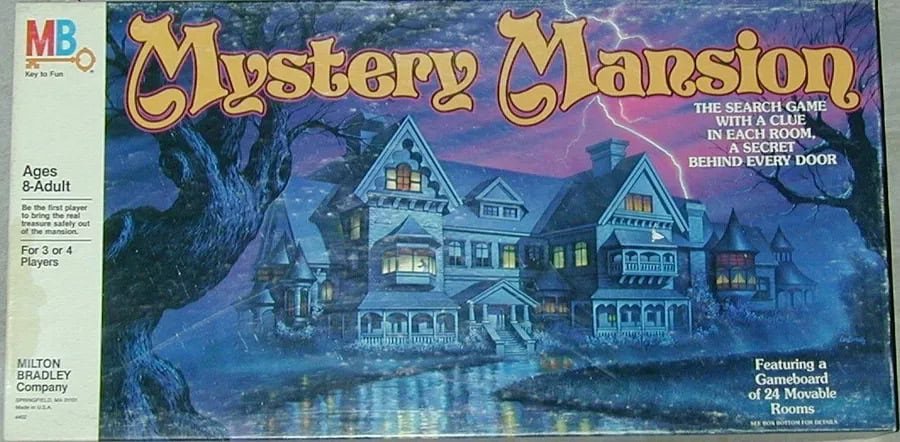
Age: 8+ (Community 6+) Players: 3-4 Time: 90 minutes
At first glance, you might think Mystery Mansion mirrors the classic board game of Clue, but, in fact, the storyline and gameplay are quite different. While in Clue you’re hunting for the killer, in Mystery Mansion you’re hunting for treasure – and the chance to build an incredible Victorian manor house.
Players search the Mystery Mansion for hidden glories and build up the mansion by adding new rooms onto existing ones, using the custom die included with the game. Each room, though, contains objects where treasures may hide, and players must search high and low to find the Real Treasure. You’ll want to add on the rooms you think will contain the best baubles, but you’ve gotta draw the right cards. Search cards permit you to look under, inside, or behind objects for clues. And if your search card matches the room your pawn is in, you gain a Clue card. You could discover a Key to a chest, a Treasure Chest, a Secret Passage, or just cobwebs. If you match a key to a chest you own, you can haul it out and look: did you find the Real Treasure or are you coughing up dust?
Totopoly
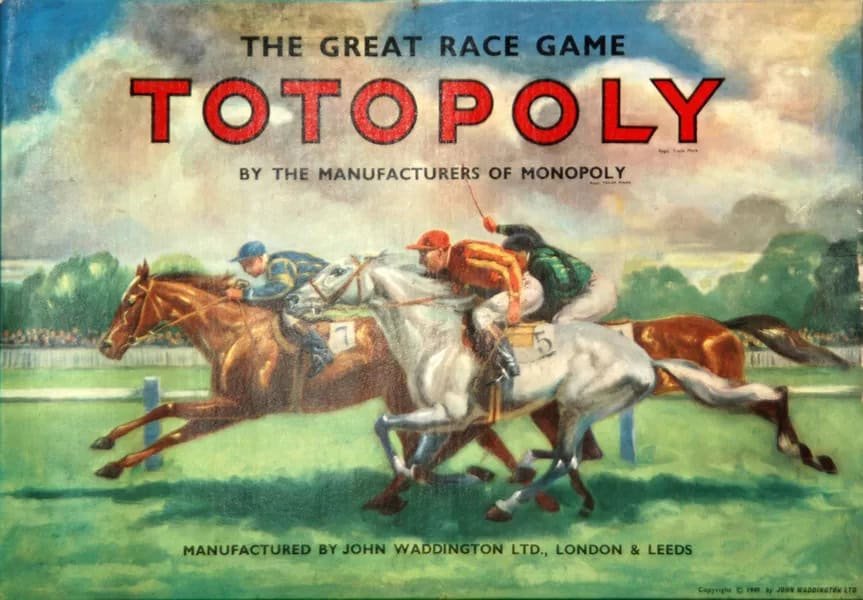
Age: 8+ Players: 2-6 Time: 90 minutes
From the makers of Monopoly comes the classic horse racing game Totopoly. The vintage board game sets the objective as “the player with the winning horse wins,” but later editions of the same game make the goal about the money instead of the race.
Each player starts out with £700 and may then buy horses or businesses by lot or by auction. Players then take a lap around the Training Track with their horses. Through this practice lap, players can collect disadvantage or advantage cards to use in the upcoming race. Money can be bet on these training rounds, as well, so players may earn some capital as they prepare for the big race.
After the training lap has been completed, the gameboard is flipped and the Race Track is revealed. Now, it’s time for the race! Players enter up to 3 horses in the race, bet on any horse (their own or another’s) and the race begins. The race advances through dice rolls and the use of the cards drawn during the training lap. Whoever winds up with the most money in the end (not always the winning final bet!) produces the winning player.
Scattergories
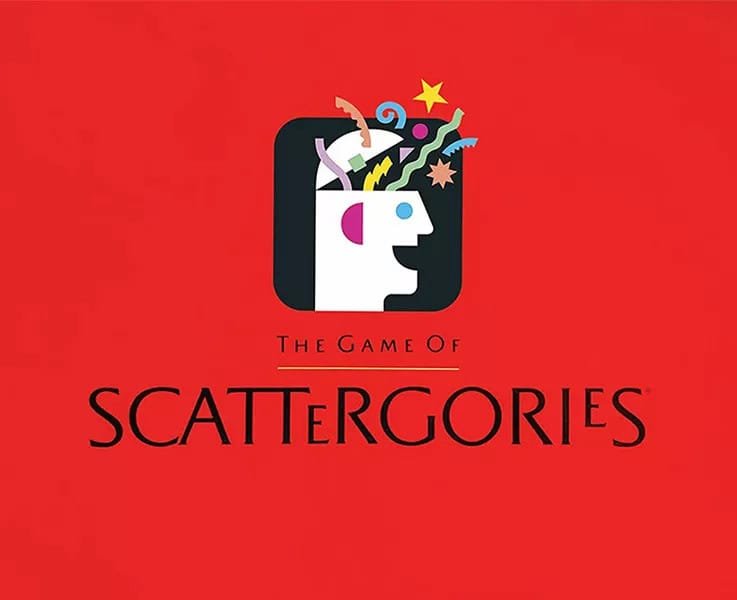
Age: 12+ (Community 10+) 2-6 Players: Time: 30 minutes
From Milton Bradley Games, published in 1988, the vintage Scattergories is a classic group game for up to 6 people. This word game was based on the old parlor game known as Categories or Guggenheim and formalized into the familiar board game beloved by millions today. Vintage card games like Old Maid and Crazy Eights also hold a special place in the hearts of collectors and players.
The game, playing roughly 30 minutes and appropriate for kids 12 and up (10 and up according to the board gaming community) uses the alphabet combined with predetermined categories to create the gameplay. The official player count goes up to 6, but many folks opt to play in teams, especially for parties, larger gatherings, or couples’ game nights.
At the top of each round, a category is named, and players then must use the letter selected for the round and come up with as many items that fit the category as possible. For example, if “B” is the letter and “sports” is the category, folks could answer baseball, basketball, bungee jumping, or badminton. The goal, however, is to list unusual options that other players won’t think of first. Whoever has the most answers that qualify and aren’t also guessed by other players or teams wins that round. (It should be noted that this is a fantastic game for virtual game nights, too! Have all players call in for a fantastic long-distance fun night!)
Identifying Rare and Valuable Games
Identifying rare and valuable vintage board games requires a combination of research, knowledge, and attention to detail. One way to start is by checking online marketplaces, such as eBay and Etsy, to see what similar games are selling for. You can also consult price guides, such as the ones published by BoardGameGeek, to get an idea of a game’s value. Additionally, look for games that are in good condition, with all their original components and packaging intact. Rare and valuable games often have unique features, such as limited edition prints or special artwork, that can increase their value. Finally, consider getting your game appraised by a professional, such as a vintage game collector or a reputable game store, to get a more accurate estimate of its value.
Also Read: The Best Classic Board Games the Whole Crew Will Love
Conclusion
Vintage board games still hold the same magic and fun that they once did. Dealing with online marketplaces can be more efficient than traditional methods like auctions. So, grab your copies (or ask Grandma for the copy she never plays anymore) and plan a game night with some of the most popular games of all time, like Mancala and Parcheesi, both at least a thousand years old. When purchasing vintage board games online, it is important to consider shipping costs. For more modern, yet still vintage fun, pull out Sherlock Holmes’ Consulting Detectives or Mystery Mansion.
FAQ
What is the oldest board game mentioned in the article?
Mancala, which originated approximately 3,000 years ago in Africa.
Can these vintage games accommodate large groups?
Yes, several games support multiple players. Scattergories supports up to 6 players (more with teams), Mexican Train supports up to 8 players, and some versions of Parcheesi can handle up to 8 players.
What’s the shortest playing time among these vintage games?
Mancala has the shortest playing time at 10 minutes per game.
Are these games suitable for young children?
Many of the games are family-friendly, with games like Mancala and Parcheesi suitable for children as young as 5-6 years old.
Which game has the most complex ruleset?
Sherlock Holmes’ Consulting Detective appears to be the most complex, requiring deductive reasoning and featuring no dice rolls or luck elements, with playing times of 60-120 minutes.








